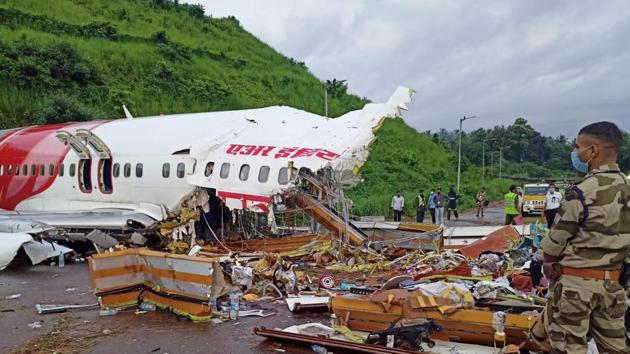Kozhikode plane crash turns spotlight on tabletop runway challenges
A report on the 2010 Mangalore air crash, prepared by a three-star officer, noted tabletop airports require extra skill and caution while carrying out flight operations.
The tragic crash at the Kozhikode airport on Friday --- an Air India Express plane with 190 on board overshot the runway and fell into a gorge --- has turned the spotlight on the challenges pilots face while operating from table-top runways and the hazards of overshooting during take off and landing, three commercial pilots HT spoke to said on the condition of anonymity.

Eighteen people, including the two pilots, were killed in the crash.
“The most obvious challenge of a tabletop runway is the fact that on a normal runway if you run out of space you would still be on the ground. On a tabletop, you may find yourself on ground several hundred feet below,” said one of the pilots cited above.
A report on the 2010 Mangalore air crash, prepared by a three-star officer, noted tabletop airports require extra skill and caution while carrying out flight operations.
Tabletop runways, located on a plateau or a hill, can also create optical illusions for pilots when they move from the instruments to the visual segment of the flight especially during bad weather, said a second pilot.
“It can be tricky as the pilot may get the illusion of not being on the correct flight profile. Add-ons like heavy rain, wet runway and pilot fatigue can complicate things further,” he said.
Tabletop airports have limited space at the ends of the runway, and several international airlines had stopped flying bigger aircraft into Kozhikode due to safety issues over the length of the runway. However, pilots flying smaller aircraft are not immune to the hazards.
“The runway is at a height which is higher than the surrounding areas and the weather conditions also differ. Sudden changes in wind pattern on approach is a common phenomenon which a pilot has to tackle. On an approach till such time you hit the tabletop you may be under the influence of some winds which vary suddenly when you reach the table making the approach management that much more difficult,” said a third pilot.
Possible variation in instrument indication when the transition to the tabletop happens is another key challenge.
“For example, the radio altimeter which calls out the height of the aircraft may call out 500 feet and a second later may call out 100 feet because you have entered the table zone. This transition to the table top is also when the winds may change which at times becomes a little tricky to manage,” the third pilot said, adding that the degree of difficulty increases manifold during the monsoons.
The Air India Express flight from Dubai was a repatriation flight carrying Indian citizens back to the country under the Vande Bharat Mission, meant to bring home stranded people from other countries amid the Covid-19 pandemic.
Wing Commander Deepak Vasant Sathe (retd), the captain of the aircraft, was a top notch Indian Air Force fighter ace who learnt his trade flying the unforgiving Soviet-origin MiG-21 fighter planes during his 22-year military career.






